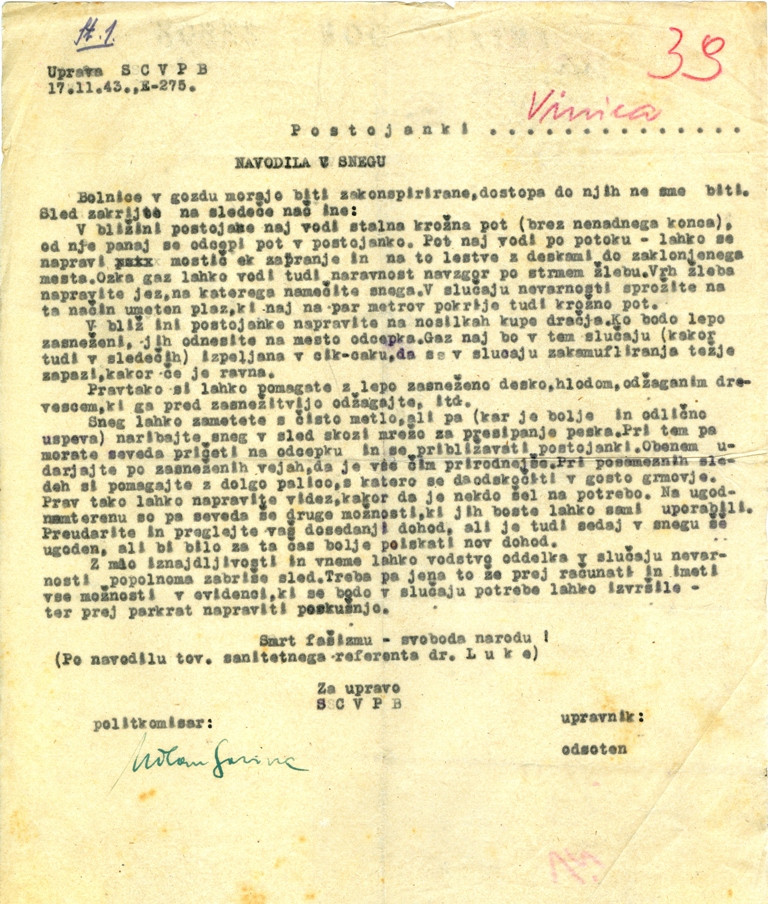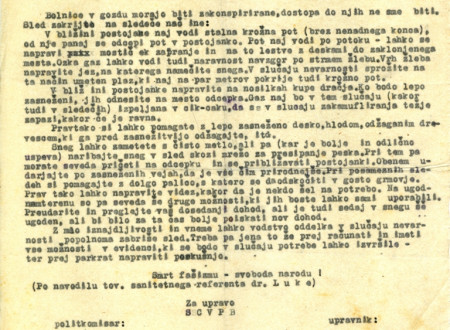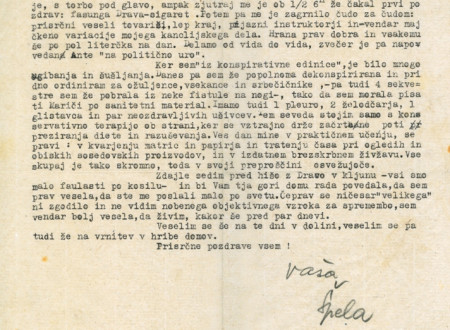Slovenian Central War Partisan Hospital and Measures to Ensure its Secrecy
Slovenian Central War Partisan Hospital and Measures to Ensure its Secrecy
Slovenian Central War Partisan Hospital (SCWPH) was founded in June 1942 in the liberated territory of Lower Carniola, where fifteen doctors and a large amount of medical supplies and equipment arrived by the end of May 1942.
The exact location for the hospital was chosen by dr. Pavel Lunaček – Igor, who also became the hospital’s first manager. Having traversed almost the entire region of Kočevski Rog, he eventually decided on a hut located on Daleč hrib. The hospital began its work on June 15 and operated continuously until the time of the Italian Roška offensive in August 1942. After that, it became apparent that there was a need for safer, secret and well-hidden hospitals, where patients could recover also during winter.
Occupying forces were aware of the fact that there were hospitals operating in the territory of Kočevski Rog, but even if they managed to come dangerously close to revealing their location, the hospitals were usually saved by measures taken to ensure their secret and hidden operation. In October 1943, the Germans discovered one of the most secretly operating partisan hospitals Pugled, set it on fire, and burnt it to the ground with its patients still inside. The patients recovering in the nearby hospital Spodnje Lašče had more luck as their medical staff had managed to evacuate them before the place was completely burnt down.
At the Jelendol partisan hospital, a special barrack was set up for SCWPH administration. The woman in charge of writing the minutes during the meetings of the heads of individual hospitals was the second lieutenant Zdenka Lušin Novak – Špela. For reasons unknown, she was at the end of May 1944 for a brief time sent to one of the partisan hospitals in Bela Krajina, where there were no such strict measures regarding the secrecy of hospital operations. Having finished several semesters at medical school, she did have some medical training and so passed her time there helping less seriously wounded patients. Although it was a time of war, she managed to keep some sense of humour, as can clearly be seen from her letter to Zoran Dobravc – Zoran Smrekar, the then deputy political commissar of the SCWPH administration. Špela set off for the valley expecting to return among her fellow “keepers of secrets” soon. By July 1, she was again writing the minutes of the meetings of hospitals’ managers, but this time Zoran Dobravc was referred to as political commissar and no longer just its deputy.
Keeping partisan hospitals well hidden and their operations secret was essential, and not many people knew about their existence/location. Hospitals needed to be set up on sparsely populated terrain. Locations were chosen by the 7th corpus, under whose administration all SCWPH branch hospitals fell in July 1944. Occasionally locations were chosen by the people operating in the field; they were the ones with the knowledge of terrain diversity, which was essential in trying to decide where to set up a hospital, since partisan hospitals could be constructed everywhere, except on plains and clearings. Karst terrain and naturally formed ditches were ideal. The forest needed to be coniferous and overgrown, but since the ground in coniferous forests tends to be softer than the ground in deciduous forests, they had to be extra careful when covering their tracks. Just how reliable and trustworthy the people in nearby settlements were is clearly demonstrated by the fact that some hospitals were able to stay on the same locations for over a year and a half. Well-organized intelligence service was equally important. Each hospital had its own checkpoint, a location to which partisans brought their wounded, who were then late in the evening or early the next morning blindfolded and taken to the hospital by the hospital staff.
Hiding entrances into such hospitals was of utmost importance. If an entrance was built among leafy trees, the person in charge of camouflage matters had to always keep a stock of leaves to cover the tracks. They would often cut down trees on their way to their checkpoints and burn them to make it look like the locals were just preparing firewood for the winter. Comings and goings from the hospitals were closely monitored as well, and couriers left the post at checkpoints. The hardest thing to camouflage was moss that was stripped off from rocks and bark stripped off from rotten tree stumps.
During wintertime special regime had to be observed. It was a bit easier for the hospitals that were accessible through running waters, but a narrow way to the entrance through the snow still had to be made. So hospital staff had to make ways through the snow all around in circles, sometimes even reaching the turns for nearby villages. Their sleighs had narrow runners so that they left behind tracks similar to those made by skies. They occasionally lifted sleighs and transported them elsewhere, and two skiers actually left that exact spot, usually to go on patrol. Those in charge of camouflage matters sometimes camouflaged such spots by planting spruce trees in a deep snow. There were special instructions for each type of snow. Some hospitals could only be reached just before it snowed so that the newly-fallen snow covered any tracks. Ideally, each hospital had enough foot and medical supply to last them through the winter; these were the so-called snowed-in hospitals.
Hospitals also had to maintain complete silence. Firewood was cut early in the morning or even inside bunkers and hospital cooks had to be careful about the smoke. Patients were often very cold due to lack of dry firewood. Roofs had to be camouflaged as well, so as to make them invisible from a plane. In winter the staff moved around wearing only white clothes. When in 1943 abbreviation SCWPH was established to denote partisan hospitals, followed by a name, point, number or letter, only the use of such a name was allowed. Those who stated the entire name of a certain hospital together with its location, were punished.
Despite constant checking of the staff, betrayals still occurred. The ones most reliable to keep a secret were usually the former patients. When a wounded person became suspicious, the staff had to be extra careful; some were handed over to partisan security units and some were even killed.
The unwritten rule of partisan hospitals was that there can never be too much secrecy.
Polona Trobec Mlakar




